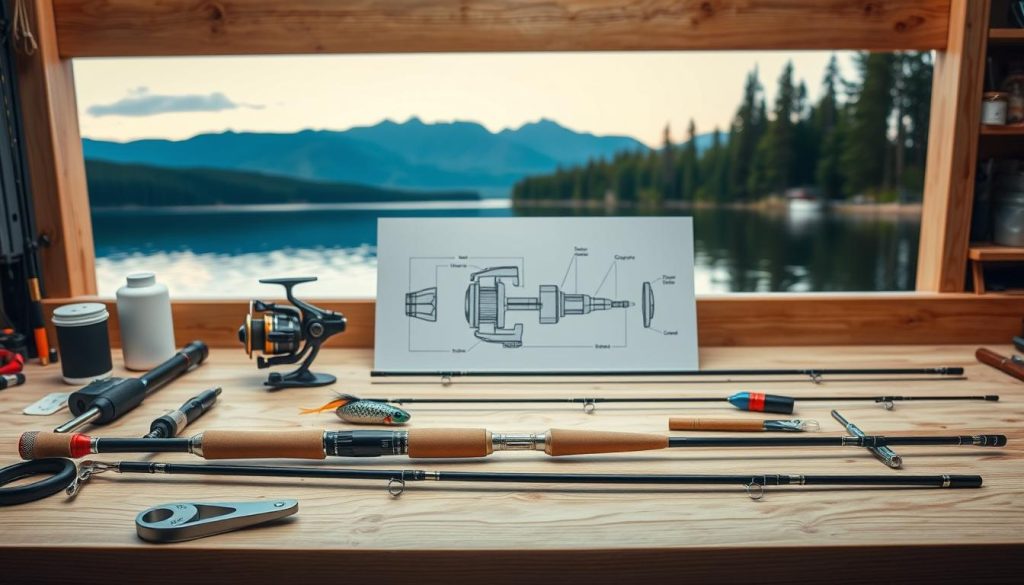Knowing how to set up a fishing pole is key for all anglers. Proper Fishing Rod Assembly can greatly boost your fishing success1. Readying Fishing Equipment needs careful focus and knowledge of your gear’s parts2.
Fishing rods are complex tools with many parts working together. These include a ferrule, grip, butt, tip, and guides2.
New anglers can gain a lot by learning how to Set Up a Fishing Pole correctly. This skill ensures they’re ready for their next fishing trip1.
Key Takeaways
- Learn the essential components of a fishing rod
- Understand proper rod assembly techniques
- Prevent damage to your fishing equipment
- Master basic setup skills for better fishing experiences
- Develop confidence in preparing your fishing gear
Essential Equipment and Materials for Fishing Rod Setup
Proper gear selection is vital for effective angling. The right equipment enhances your fishing experience and boosts your chances of success3.
- Fishing Rod: A beginner-friendly rod typically measures 7 feet in length4
- Fishing Line: Choose based on your specific fishing needs
- Reel: Select the appropriate type for your skill level
- Accessories: Hooks, weights, and other critical tools
Choosing the Right Fishing Line
Fishing line selection is crucial for success. The line’s strength is measured in “test,” indicating its breaking point3.
Anglers have three main line options:
| Line Type | Characteristics | Best Used For |
|---|---|---|
| Monofilament | Affordable, easy to tie | Beginners, versatile fishing |
| Fluorocarbon | Invisible underwater | Clear water, wary fish |
| Braided | Strongest, zero stretch | Deep water, heavy cover |
Required Tools and Accessories
A well-stocked tackle box should contain essential items for effective fishing preparation:
- Pliers for line management
- Line cutters
- Knot-tying tools
- Weights and sinkers3
- Hooks and swivels
Quality gear improves your fishing experience. It also increases your chances of landing a great catch4.
Set Up a Fishing Pole: Step-by-Step Process
Rigging a fishing rod needs careful attention and the right technique. The first crucial step is selecting the right fishing line for your needs5. Anglers can pick between braid and monofilament lines, each with unique features5.
- Secure the reel to the rod, ensuring proper alignment
- Open the bail on the reel for line spooling
- Thread the line through the rod’s guide rings carefully
- Tie a strong knot to connect the line to the reel spool
Your fishing style affects line choice. Braid lines excel for lure fishing, while monofilament works well with live bait5. New anglers should opt for heavier line sizes within recommended ranges5.
Pros suggest keeping proper line tension during setup. Getting professional line winding at tackle shops can boost quality and performance5.
Thread the line through each rod guide with care. This prevents damage and ensures smooth casting.
Rigging the Line and Leader System
Tying fishing knots is key to successful angling. A good line and leader setup can boost your fishing game. Tapered leaders come in different lengths and strengths for various fish species6.
Knot tying needs practice to perfect. The improved clinch and Palomar knots are must-know techniques. For best results, use a double line length of 1 to 2 feet6.
Strong connections between main line and leader make bait setup more effective. This knowledge can greatly improve your catch rate.
Essential Knots for Setup
The right knots can make or break your fishing success. The Bimini Twist works great for mono lines under 80 pounds6.
Pros often use a 20-foot mono leader on charters. This gives flexibility and protects against line wear6.
Your knot choice and leader setup matter in different fishing spots. They can be crucial for landing fish in reefs or offshore.
Leader Configuration Tips
Leader length matters in various fishing situations. For lines up to 20 pounds, keep the double line and leader under 20 feet6.
Longer leaders work well for bigger fish. They allow for multiple trims and quick retying during active fishing6.
Mastering these techniques will prep you for many fishing adventures. You’ll be ready to set up your pole for any challenge.
FAQ
What’s the most important thing to consider when selecting a fishing rod?
How do I choose the right fishing line?
What basic tools do I need to set up my fishing pole?
How do I attach the reel to my fishing rod correctly?
What’s the best knot for attaching a hook or lure?
How much line should I spool on my reel?
How often should I replace my fishing line?
What’s the difference between a leader and regular fishing line?
Source Links
- Back To Basics – Fishing Rod & Line Setup Guide – Fulling Mill Blog – https://blog.fullingmill.com/back-to-basics-fishing-rod-line-setup-guide/
- How to Set Up a Fishing Pole: 14 Steps (with Pictures) – wikiHow – https://www.wikihow.com/Set-Up-a-Fishing-Pole
- Beginner’s Guide to Fishing Rods + Tackle – Go Fish BC – https://www.gofishbc.com/learn/fishing-tips/lake-fishing/beginners-guide-to-fishing-rods-tackle/
- Top 10 Essential Fishing Gear and Equipment for Beginners – https://riteangler.com/blogs/news/top-10-essential-fishing-gear-and-equipment-for-beginners?srsltid=AfmBOoqCThDUNwBRg8z1a8rlUryTXbWzDqbKpm7XXy1_joh2zhxh5cuy
- How To Rig A Fishing Rod And Reel – https://www.boatus.com/expert-advice/expert-advice-archive/2018/june/how-to-rig-fishing-rod-and-reel
- Building A Light-Line Leader System – Fishing Light Leader System – http://www.bdoutdoors.com/article/offshore-academy-how-to-build-a-light-leader-system
